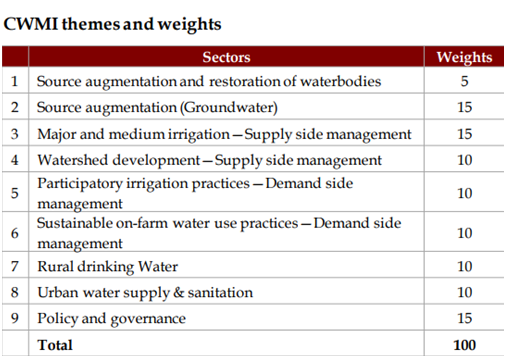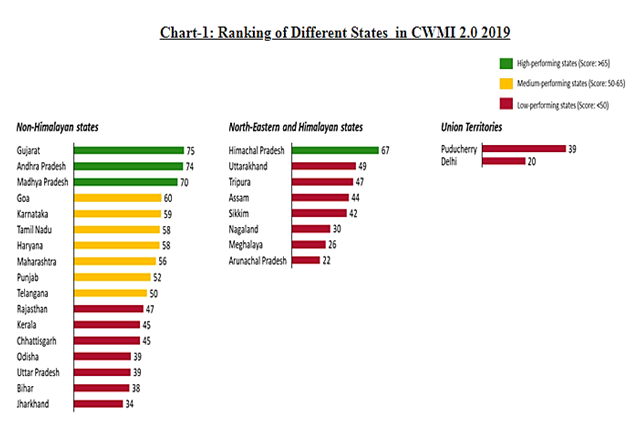Composite Water Management Index 2.0
- 23 Aug 2019
On 23rd August, 2019, the National Institute for Transforming India (NITI) Aayog released the 2nd edition of Composite Water Management Index (CWMI) 2.0.
- This index has been prepared by NITI Aayog in partnership with Ministry of Jal Shakti, Ministry of Rural Development and all the States/ Union Territories.
Objectives
- To keep tab on the momentum on management of water.
- To supplement the efforts of Jal Shakti Ministry towards Jal Sanchay, Jal Sanrakshan and Jal Sinchan across the country.
About the CWMI 2.0
- The CWMI-2019 measures the performance of States on a comprehensive set of water indicators and reports relative performance in 2017-18 as well as trends from previous years (2015-16 & 2016-17).
- The Index comprises of 9 themes, and covers 25 states and 2 UTs.

- The nine themes are further sub-divided into 28 indicators which account for equal weightages within respective themes.
- Critical areas such as source augmentation; major and medium irrigation; watershed development; participatory irrigation practices; sustainable on-farm water use practices; rural drinking water; urban water supply and sanitation; and policy & governance have been accorded high priority.
Composite Water Management Index (CWMI)
Objectives
|
Key Findings of the Report
- Gujarat hold on to its rank one in the reference year (2017-18), followed byAndhra Pradesh, Madhya Pradesh, Goa, Karnataka and Tamil Nadu.
- In North Eastern and Himalayan States, Himachal Pradesh has been adjudged number 1 in 2017-18 followed by Uttarakhand, Tripura and Assam.
- The Union Territories have first time submitted their data and Puducherry has been declared as the top ranker.
- In terms of incremental change in index (over 2016-17 level), Haryana holds number one position in general States and Uttarakhand ranks at first position amongst North Eastern and Himalayan States.
- On an average, 80% of the states assessed on the Index over the last three years have improved their water management scores, with an average improvement of +5.2 points.
- Jharkhand, Uttar Pradesh, Odisha, Bihar, Nagaland, and Meghalaya still scoreless than 40 points.
- Uttar Pradesh, Rajasthan, Kerala, and Delhi, 4 of the top 10 contributors to India’seconomic output, have scores ranging from 20 points to 47 points.
- None of the top 10 agricultural producers in India, except Gujarat and Madhya Pradesh, score more than 60 points on the CWMI.

Significance
- Tool of Assessment:It is an important tool to track performance in the water sector and take corrective measures timely for achieving better outcomes thereby meeting the citizens’ expectations satisfactorily.
- Helps in Better Water Management:It would provide useful information for the States and also for the concerned Central Ministries/Departments enabling them to formulate and implement suitable strategies for better management of water resources. This benchmarking exercise can go a long way in creating a common frame for progress for water in India and also highlight the need for specific improvements.
- Encouraging Cooperative Federalism: It represents a major step towards creating a culture of data-based decision-making for water in India, which can encourage competitive and cooperative federalism in the country’s water governance and management.
State Water Conservation ModelsMukhya Mantri Jal Swavlambhan Abhiyan , Rajasthan
Neeru-Chettu Programme, Andhra Pradesh
Jalyukt Shivar Abhiyan, Maharashtra
Mission Kakatiya, Telangana
Sujalam Sufalam Yojana, Gujarat
Pani Bachao Paise Kamao, Punjab
|
Way Forward
- Scientific management of water is increasingly recognized as being vital to India’s growth and ecosystem sustainability. From policy perspective, water management has four major dimensions: Access, Quality, Sustainability and Efficiency. In order to get better outcomes, each dimension can be developed as a simple index reflecting the performance of the states.
- The Index and its annual reporting are one step in a long journey towards improved water management, and focus on setting the necessary foundation of a high-quality data culture within federal and state water institutions.
- Importantly, Government along with states must supplement urgent top-down water legislations with a grassroots management approach that involves local community organizations, NGOs, farmer groups, and industry bodies in ideation and implementation of water related policies and projects and make sure that the index should not just restrict itself to becoming a common platform for water data.



